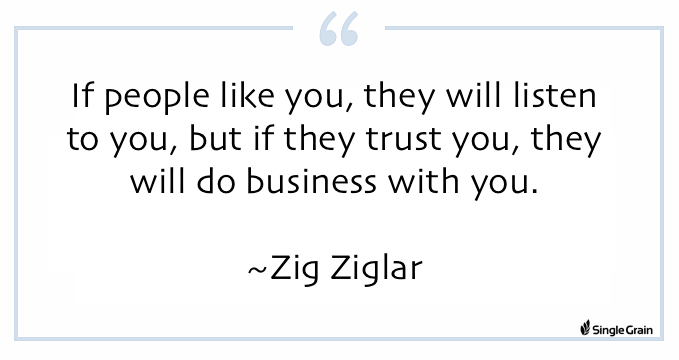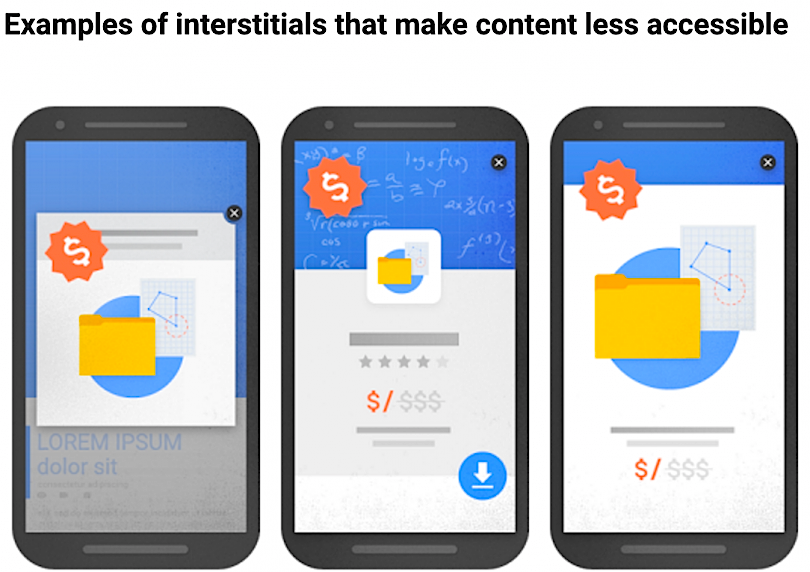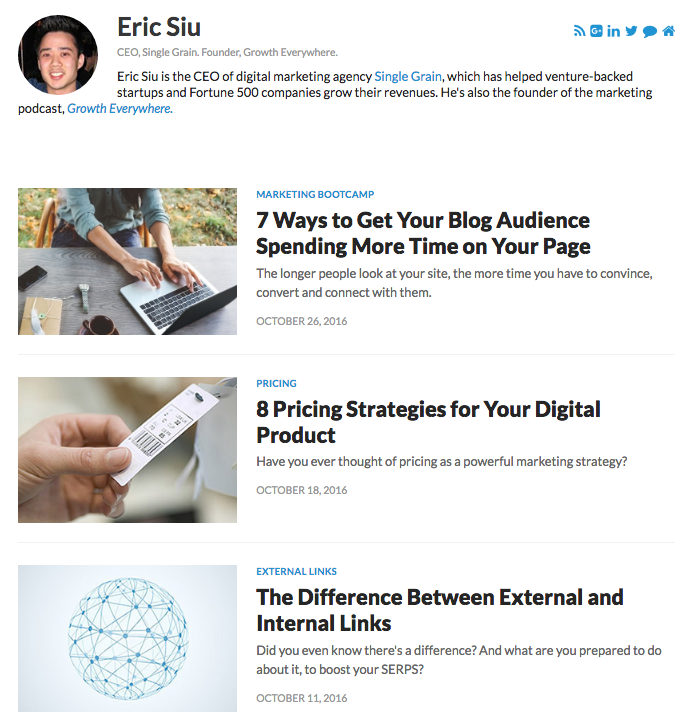Every website is clamoring for one thing: attention. Attention from Google, attention from customers and potential customers, and social media attention. The greater the number of people who read your blog post, the more likely that it will be shared and even linked to from others’ websites or in posts they write.
But you’ll only get attention if your content is high quality.
So how do you define high quality? There are a number of factors, but it primarily comes down to one thing: trust.
Content marketing is one of the best and easiest methods of customer acquisition, but in order to succeed, you have to win over your potential customers by demonstrating that you are a trustworthy brand who is interested in their happiness more than your bank account. Nobody is going to shell out their hard-earned dollars if they don’t trust you.
The beauty and the pain of thousands of brands competing for attention online (64.3 million new posts are published each month!) is that if you betray a customer’s trust even once, you’ve probably lost them for good.
Loyalty vs. Trust

Earning or betraying a customer’s trust doesn’t just relate to providing excellent customer service at the time of the sale, or when resolving complaints and poor experiences. It’s more foundational, more long-term — it’s about establishing customer loyalty and retention.
- 83% of consumers say that their loyalty is primarily a result of trust
- 65% of Millennials and 70% of Gen X and Baby Boomers say that value for their money is an important loyalty driver
When issues arise, “coupons and gift cards can demonstrate that you value feedback and that you are willing to acknowledge bad experiences and provide some recompense,” says Ryan Stewart of Market Force. “However, many consumers simply want to know that your organization cares about their concerns and acts upon them.”
Customers are more than willing to remain loyal (it’s the path of least resistance) as long as you keep their trust. But the initial trust comes long before they ever purchase your product, and probably begins when they first visit your website.
Here are five ways you can build trust with customers or potential customers:
Build Trust through User Experience
Before users even get to your content, your website makes a strong and lasting first impression. And it’s not just website visitors whose opinions count; Google is paying attention, too. The search giant is starting to penalize sites that do things that people have hated for a long time, such as:
- spreading out one article over sometimes dozens of pages
- huge pop-up ads that block out most of the page
- pop-ups that you must close before you can even get to the content

Image Source: Mashable
If you are still doing these things on your website, whether in an attempt to move up in the index by forcing users to go through more pages (spread-out pagination), build your e-mail list or monetize your site through huge ads, stop. Now. Unless a visitor is very interested in what you have hidden behind that annoying ad, they will likely go look elsewhere for the information they are after or the product or service they need.
Build Trust Through Value
To establish trust with your website visitors, your site needs to offer information that their customers find valuable, whether that is product information, honest reviews, DIY projects, how-to’s or guides, or even information about your company.
Many sites fill their blog with general information, generic descriptions, and very little of substance. As a result, website visitors get annoyed at having clicked on a link to the blog only to see nothing of value — and nothing that differentiates that company from any other in the industry. Everyone claims that their product or service is the best, but to really set your brand apart, you must offer your site visitors something of unique value.
What is unique value? It’s content that is unavailable or difficult to obtain elsewhere, detailed, well researched and cited, and professionally produced. It could be:
- data that you’ve gathered and presented in a unique way
- your expert opinion on info that’s already out there
- in-depth analysis on a subject
- a helpful written or video guide on how to accomplish something
- or anything else that makes people want to save it for future reference or share it with their friends
This increases a viewer’s trust in you, as well as the likelihood of them looking to you as reliable, go-to source when they want to know something.
The criteria for value of content includes several points:
- One of a Kind: does not appear anywhere else on the web (as an exact duplicate)
- Relevant: answers the query that the searcher asked (according to both humans and search engines)
- Helpful: is useful and efficient in the way that it answers the question
This type of content might cost more or be harder to create, but it also generates the most organic traffic.
Build Trust Through Your Expertise
Providing content that has unique value establishes you or your brand as an expert. That expertise not only matters to your site visitors, it also matters to Google. Becoming an expert according to Google involves sharing your expertise on other sites as well as your own.
For example, Single Grain CEO Eric Siu regularly guest blogs on other noteworthy sites such as Entrepreneur and HubSpot, which not only helps establish him as an expert, but helps the SEO of his own brand.

Google evaluates pages based on the E.A.T. principle, which stands for:
- Expertise: the page needs to have quality content written by an expert writer
- Authority: the site itself needs to have some authority on the subject
- Trustworthiness: the site needs to have other authoritative links pointing to it from trusted sites
This is even more critical if you are in an industry that is determined by Google to be a Your Money or Your Life (YMYL) category, such as shopping, financial, medical, and legal.
When a site visitor sees that you are recognized as an expert by other organizations, or with reviews, recommendations, and awards, your brand’s trustworthiness immediately skyrockets.
Learn More: 5 Steps to Becoming an Expert Content Creator (According to Google’s Phantom Update)
Build Trust Through Free Content
Creating valuable, high-quality content is going to cost you — whether that be time or money.
So how do you pay for it? The ROI on content marketing is a long-term gain, and you may be anxious to recoup some of your investment as quickly as possible. But offering free content adds extreme value to your site as it allows you to start building a relationship with potential customers (not to mention maintain your relationship with current ones).
If you’re hesitant to create a whole new piece of content for the purpose of giving it away, take a look around at your large collection of content and see how you can repurpose it. You probably have case studies, frequently asked questions from customers or other data that you can draw from and turn into something more palatable, like:
- a handy infographic to show off industry stats
- a downloadable PDF/e-book with images
- a short podcast or interview
- a short how-to video, explainer video or product demo
Free content also has the ability to weed out deadbeat customers. Though giving away information that will help people solve problems on their own may seem counterintuitive, it can actually work in your favor: once they see how much work your service takes, many people would rather pay you than do it themselves. It also eliminates those “potential” customers or clients who aren’t interested in paying for your services anyway so you don’t have to waste your time.
“Give away information snacks to sell knowledge meals,” says Jay Baer. “You must take what you know, turn it into bite-sized chunks, and put it out there to be consumed by prospects.”
Consider this: if 84.3% of people visit a business’ website prior to buying something from them, why not take advantage of that opportunity by giving them a “party favor”—something of value that they can use and that continues to remind them of you. When they’re ready to make a purchase, chances are that they will do so from your brand.
But free means free. No paywalls, no required sign-ups for your e-mail list, and no whole page pop-up ads before they get the free content. Give the information away to anyone who visits your site without any obligation on their part. Of course, do offer them the opportunity to subscribe to your e-mail list. Just don’t force them to.
Read More: Why Neil Patel Pays $30,000 for Content & Gives it Away For Free [podcast]
Build Trust Through Careful Sharing
You can have the greatest content in the world, but if no one sees it, you won’t reap any benefits from it. While Google does not take into account social shares when it comes to ranking, shares do affect organic traffic, which directly affects how likely someone is to link to your content on their own.
Therefore, sharing your content through your social channels is essential. At the same time, a simple shotgun approach of posting every piece of content the exact same way across every social channel is foolish, and will make your followers think you are just being lazy.
Share Uniquely to Each Network. Content needs to be marketed to each channel differently.
- LinkedIn posts do well when accompanied by meaningful text.
- Facebook’s algorithm gives preference to video content, so even a short video to accompany your text can expand its reach.
- Twitter is ideal for short sound bites, and tweets that include images get 150% more retweets than those without.
Some testing and analysis will make it clear which type of content will perform better for you.
Post at Ideal Times and Days for Widest Reach. Each social platform benefits from posting on specific days of the week and times of day. For instance:
- Facebook – Thursday/Friday early afternoon
- Twitter – Monday-Friday (B2B) or Wednesday-Sunday (B2C) at 12 p.m. or 6 p.m.
- LinkedIn – Tuesday-Thursday at 10-11 a.m. or 5-6 p.m.
- Instagram – Monday-Sunday off-work hours
Automate for the Best Results. Obviously, you will have to test to see which days and times are ideal for your industry/brand, and sometimes the ideal times are not always convenient to you or your staff. This is where automation comes in. However, automated posting can create its own issues.
- Be careful with humor. Brands have gotten into trouble over ill-timed humor that was a part of automated posts that could not be cancelled in time. Be cautious with what you joke about.
- Don’t schedule too far out. What is relevant today may be eclipsed by a headline next week.
- Maintain control. Even outside of business hours, have someone in charge of your automated posts who can alter or cancel them if need be.
Remember, to get better ROI from automation, put your customer first, ahead of your content. Combine all your analytics to determine which content is helping you generate new leads and nurture the clients you have.
Related Content: Automation Master Brad Martineau on How to Set Up Successful Sales & Automation Funnels [podcast]
Promote Posts that Perform Well. Another way to increase ROI is to use those same social analytics to see which posts are performing well, and promote them through paid ads. Again, a shotgun approach does not provide the best value, but targeted ads provide great click-through rates if delivered to the right audience.
One of the best ways to earn the loyalty of your customers and attract new ones is to establish trust, and excellent content is arguably the best way to do so. Offering value and expertise through free content helps to build a long-term relationship grow your audience.



